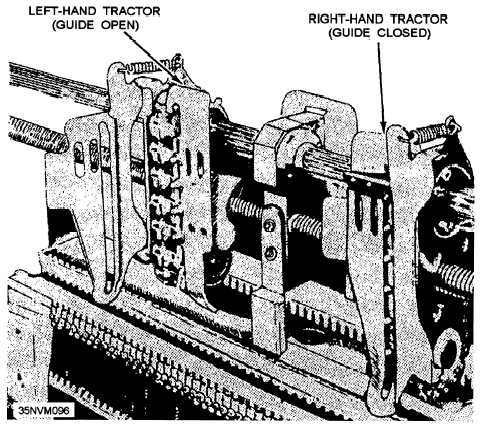CONTROL PANEL
The control panel allows the operator to set the
printer’s operating parameters such as font, characters
per inch, and print quality. The operator may also be
able to run a self-test to check various fonts and print
quality. The control panel can also be used to advance
the paper to the top of the form or advance the paper
one line. There is usually a switch to control whether
the printer is online or offline. When operators perform
any actions with the control panel, they should be sure
the printer is offline to prevent any stray interrupts being
sent to the host computer.
PAPER-FEED ASSEMBLIES
The two most common methods of feeding paper
through a printer are the tractor feed and friction feed.
Some printers may have both friction feed for
single-sheet paper and tractor feed for continuous paper.
Tractor Feed
Tractor feed is probably the most common of all
paper-feed methods. It is easily recognized by the type
of paper used and the tractors that actually move the
paper. Figure 12-3 shows the basic components of a
tractor paper-feed assembly. Tractor feed uses
continuous paper with perforated holes on each side.
The paper is threaded through the printer’s platen to the
tractor’s sprockets. The perforated holes on each side
of the paper are lined up with the sprockets and the paper
is held in place when the sprocket covers are closed.
The paper is advanced by a paper-feed motor. This
is generally a stepper-type motor, where each step
advances the paper one line. The paper-feed motor
turns the platen, which is connected to the tractors by a
drive belt or a set of gears.
Friction Feed
Printers using a friction-feed paper advance are
capable of handling both continuous flat folded and
single sheets of paper. With friction feed, the paper is
held firmly against the platen by a pressure roller. To
advance the paper, the paper motor turns the platen,
which causes the paper to advance.
Another type of friction feed, the sheet feeder, is
common in laser printers and uses a series of rollers to
transport the paper through the printer. Figure 12-4
illustrates the basic operation of this type of paper feed.
The pick up roller picks the top sheet of paper in the
tray. A separation pad ensures that only one sheet of
Figure 12-3.—A tractor-feed assembly.
12-6


